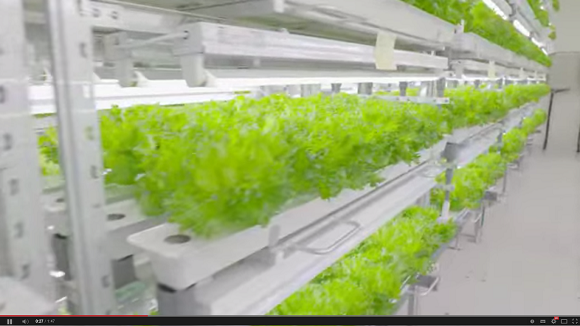
With Vermont becoming the first state in the US to require labels for genetically modified organisms, more and more people are turning towards natural, organically grown food. People want to know where their food comes from and they want to have the choice to choose foods that don’t use pesticides. But genetically modified food has been paramount to feeding every mouth on this planet. What if there was a way to combine the benefits that science provides but still ensure a natural growing environment with no pesticides used? Fujitsu is taking great strides towards that goal and their first product has been making its way to consumers.
And yes, we really are taking about food by Fujitsu.
Fujitsu is better known for its electronics and appliances, but when the unique opportunity of an empty 2,000 square meter clean room presented itself, Fujitsu decided to produce something new that they had been researching…produce! With the unique environment of a clean room, Fujitsu installed growing lights and irrigation to create a one of a kind high-tech agriculture facility.
Fujitsu teamed up with Aizufujikako and the Fukushima Medical University to grow low-potassium, pesticide free, low bacteria and low-nitrate nitrogen vegetables. Low-potassium vegetables that can be eaten raw are incredibly useful for the dietary needs of people with kidney disease, which affects over 15 million people in Japan. Nitrate-Nitrogen (what causes the bitter taste) is also considerably reduced and the natural sweet flavor of the lettuce is brought to the surface. This makes the lettuce extremely easy to eat.
Daily output is expected to be 3,500 heads of lettuce when in full production. Cultivated in a clean room, the vegetables carry few bacteria and therefore have a longer shelf life (up to two weeks). Although the price is expected to be three to four times higher than a normal head of lettuce, main customers will include hospitals and department stores in and outside of Fukushima.
This lettuce is the first of its kind produced by Fujitsu working under the Akisai Cloud Service. A program started in July 2012, it applies IT technology to food production. Fujitsu hopes to continue producing these superior vegetables with the help of Aizufujikako and Akita Prefectural University. The 2013 advanced agricultural production system is one of many initiatives supporting the recovery of the Tohoku region after the Great East Japan Earthquake of 2011. As production continues to rise and new crops are produced, Fujitsu will require the technical and agricultural know-how of those who might not have a farm themselves anymore.
Annual sales are targeted at 150 million yen (about $1.5 million) in 2014, and rising to 400 million yen (about $4 million) in 2016. Here’s to hoping Fujitsu can successfully produce different types of low-potassium vegetables for the people suffering from kidney disease, and for the people of Fukushima.
▼”The clean room drastically reduces bacteria and dust.”
▼”The temperature, level of humidity, concentration of CO2, air flow, light levels, and nutrients are all directly managed.”
▼”The cultivation environment can be controlled from anywhere using a tablet.”
Source: NariNari
Additional Information: METI Aizufujikako, Fukushima Minpo News, semiconportal
Images: YouTube (FUJITSU Japan)

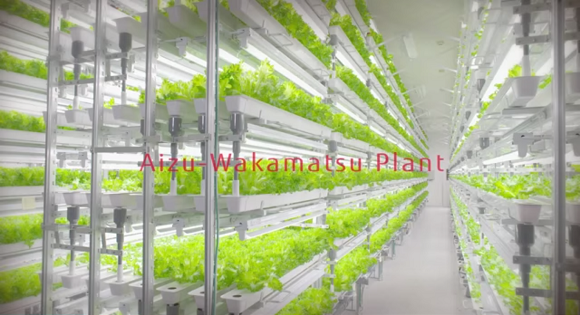
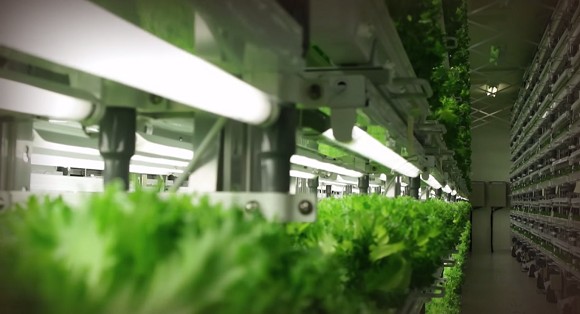
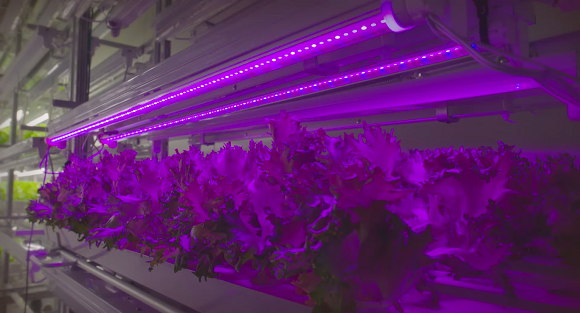
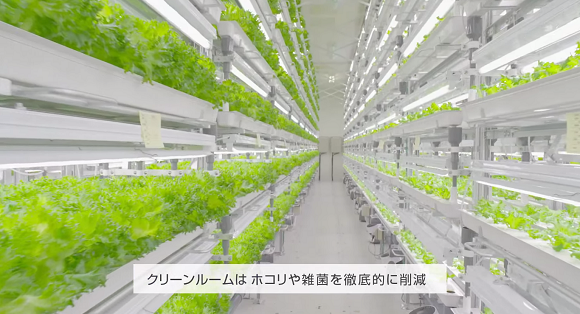
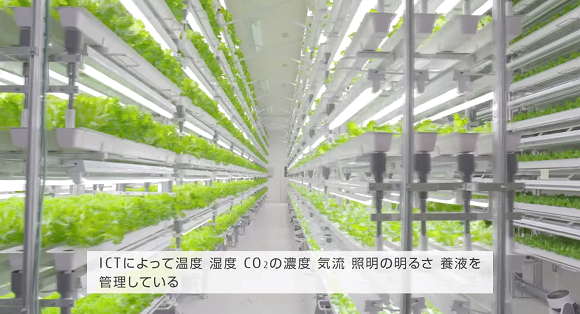
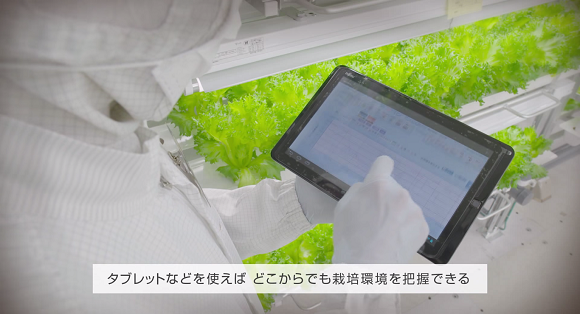
 Tokyo Metro has a new request, “Eat our vegetables!”
Tokyo Metro has a new request, “Eat our vegetables!” LED plant factories offer efficient 3D alternative to traditional gardening
LED plant factories offer efficient 3D alternative to traditional gardening Japan’s ‘agri-tech’ farming revolution
Japan’s ‘agri-tech’ farming revolution Anti-insect laser gun turrets designed by Osaka University, expected to work on roaches too
Anti-insect laser gun turrets designed by Osaka University, expected to work on roaches too Ueno Station has signs that show ambient sounds as onomatopoeia for deaf passengers
Ueno Station has signs that show ambient sounds as onomatopoeia for deaf passengers McDonald’s new Happy Meals offer up cute and practical Sanrio lifestyle goods
McDonald’s new Happy Meals offer up cute and practical Sanrio lifestyle goods All-you-can-drink Starbucks and amazing views part of Tokyo’s new 170 meter-high sky lounge
All-you-can-drink Starbucks and amazing views part of Tokyo’s new 170 meter-high sky lounge Studio Ghibli releases new action figures featuring Nausicaä of the Valley of the Wind characters
Studio Ghibli releases new action figures featuring Nausicaä of the Valley of the Wind characters McDonald’s Japan releases a pancake pie for new retro kissaten coffeeshop series
McDonald’s Japan releases a pancake pie for new retro kissaten coffeeshop series Super Nintendo World expansion gets delayed for several months at Universal Studios Japan
Super Nintendo World expansion gets delayed for several months at Universal Studios Japan Studio Ghibli glasses cases let anime characters keep an eye on your spectacles
Studio Ghibli glasses cases let anime characters keep an eye on your spectacles More foreign tourists than ever before in history visited Japan last month
More foreign tourists than ever before in history visited Japan last month The oldest tunnel in Japan is believed to be haunted, and strange things happen when we go there
The oldest tunnel in Japan is believed to be haunted, and strange things happen when we go there Randomly running into a great sushi lunch like this is one of the best things about eating in Tokyo
Randomly running into a great sushi lunch like this is one of the best things about eating in Tokyo Pokémon dress shirts progress into Gen 2 with 100 brand-new Johto region designs【Photos】
Pokémon dress shirts progress into Gen 2 with 100 brand-new Johto region designs【Photos】 Disney princesses get official manga makeovers for Manga Princess Cafe opening in Tokyo
Disney princesses get official manga makeovers for Manga Princess Cafe opening in Tokyo Starbucks reopens at Shibuya Scramble Crossing with new look and design concept
Starbucks reopens at Shibuya Scramble Crossing with new look and design concept Beautiful new Final Fantasy T-shirt collection on the way from Uniqlo【Photos】
Beautiful new Final Fantasy T-shirt collection on the way from Uniqlo【Photos】 Is the new Shinkansen Train Desk ticket worth it?
Is the new Shinkansen Train Desk ticket worth it? Foreign English teachers in Japan pick their favorite Japanese-language phrases【Survey】
Foreign English teachers in Japan pick their favorite Japanese-language phrases【Survey】 Beautiful Sailor Moon manhole cover coasters being given out for free by Tokyo tourist center
Beautiful Sailor Moon manhole cover coasters being given out for free by Tokyo tourist center Studio Ghibli releases Kiki’s Delivery Service chocolate cake pouches in Japan
Studio Ghibli releases Kiki’s Delivery Service chocolate cake pouches in Japan Japan’s bone-breaking and record-breaking roller coaster is permanently shutting down
Japan’s bone-breaking and record-breaking roller coaster is permanently shutting down New definition of “Japanese whiskey” goes into effect to prevent fakes from fooling overseas buyers
New definition of “Japanese whiskey” goes into effect to prevent fakes from fooling overseas buyers Our Japanese reporter visits Costco in the U.S., finds super American and very Japanese things
Our Japanese reporter visits Costco in the U.S., finds super American and very Japanese things Studio Ghibli unveils Mother’s Day gift set that captures the love in My Neighbour Totoro
Studio Ghibli unveils Mother’s Day gift set that captures the love in My Neighbour Totoro Domino’s Japan now sells…pizza ears?
Domino’s Japan now sells…pizza ears? New Japanese KitKat flavour stars Sanrio characters, including Hello Kitty
New Japanese KitKat flavour stars Sanrio characters, including Hello Kitty One of Tokyo’s most famous meeting-spot landmarks is closing for good
One of Tokyo’s most famous meeting-spot landmarks is closing for good Kyoto creates new for-tourist buses to address overtourism with higher prices, faster rides
Kyoto creates new for-tourist buses to address overtourism with higher prices, faster rides Sales of Japan’s most convenient train ticket/shopping payment cards suspended indefinitely
Sales of Japan’s most convenient train ticket/shopping payment cards suspended indefinitely Sold-out Studio Ghibli desktop humidifiers are back so Totoro can help you through the dry season
Sold-out Studio Ghibli desktop humidifiers are back so Totoro can help you through the dry season Japanese government to make first change to romanization spelling rules since the 1950s
Japanese government to make first change to romanization spelling rules since the 1950s Ghibli founders Toshio Suzuki and Hayao Miyazaki contribute to Japanese whisky Totoro label design
Ghibli founders Toshio Suzuki and Hayao Miyazaki contribute to Japanese whisky Totoro label design Doraemon found buried at sea as scene from 1993 anime becomes real life【Photos】
Doraemon found buried at sea as scene from 1993 anime becomes real life【Photos】 Tokyo’s most famous Starbucks is closed
Tokyo’s most famous Starbucks is closed One Piece characters’ nationalities revealed, but fans have mixed opinions
One Piece characters’ nationalities revealed, but fans have mixed opinions We asked a Uniqlo employee what four things we should buy and their suggestions didn’t disappoint
We asked a Uniqlo employee what four things we should buy and their suggestions didn’t disappoint Princesses, fruits, and blacksmiths: Study reveals the 30 most unusual family names in Japan
Princesses, fruits, and blacksmiths: Study reveals the 30 most unusual family names in Japan This super-rare Japanese banana has edible skin!【Taste test】
This super-rare Japanese banana has edible skin!【Taste test】 Ex-plant worker jailed for 42 months for tainting frozen food
Ex-plant worker jailed for 42 months for tainting frozen food Japanese people react to reading that “pizza is a vegetable in America”
Japanese people react to reading that “pizza is a vegetable in America” Freaky veggies trending in Japanese groceries, possible precursor to real-life “The Last of Us”
Freaky veggies trending in Japanese groceries, possible precursor to real-life “The Last of Us” Instant ramen with 40 billion lactic acid bacteria on sale now
Instant ramen with 40 billion lactic acid bacteria on sale now Fear of food produced in China continues as new report claims at least 48% of it will make you sick
Fear of food produced in China continues as new report claims at least 48% of it will make you sick Genetically altered rice could solve Japan’s pollen allergy problem
Genetically altered rice could solve Japan’s pollen allergy problem China’s polluted rivers can be surprisingly pretty, but might turn you into a mutant
China’s polluted rivers can be surprisingly pretty, but might turn you into a mutant New hemp mascot character Asamiko-chan appears in Japan
New hemp mascot character Asamiko-chan appears in Japan Nagoya University develops rice plant that grows pure sugar
Nagoya University develops rice plant that grows pure sugar Shizuoka Prefecture may lose title of Japan’s top tea producer to rising star Kagoshima
Shizuoka Prefecture may lose title of Japan’s top tea producer to rising star Kagoshima McDonald’s releases new rice burgers in Japan
McDonald’s releases new rice burgers in Japan Penis peach found, appetites lost in Japan
Penis peach found, appetites lost in Japan We tried Japan’s peach-flavored potato chips, and they do not disappoint in their peachiness
We tried Japan’s peach-flavored potato chips, and they do not disappoint in their peachiness Future Alert: In 2015 you’ll be able to use your smartphone to brush your teeth, kind of
Future Alert: In 2015 you’ll be able to use your smartphone to brush your teeth, kind of
Leave a Reply